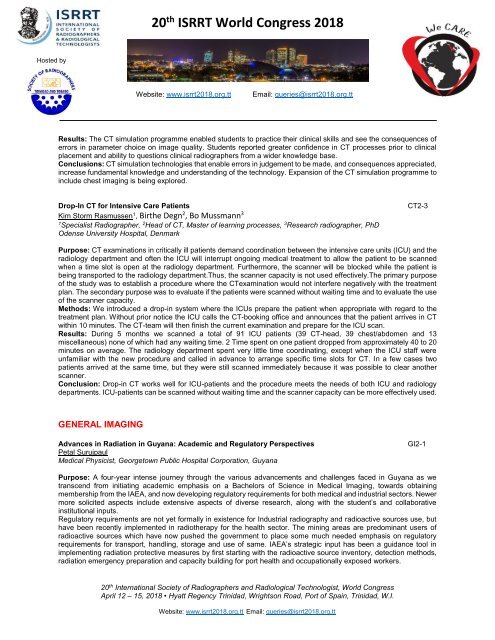Trinidad-and-Tabago-Congerss-Abstract-Book
You also want an ePaper? Increase the reach of your titles
YUMPU automatically turns print PDFs into web optimized ePapers that Google loves.
20 th ISRRT World Congress 2018<br />
Hosted by<br />
Website: www.isrrt2018.org.tt<br />
Email: queries@isrrt2018.org.tt<br />
Results: The CT simulation programme enabled students to practice their clinical skills <strong>and</strong> see the consequences of<br />
errors in parameter choice on image quality. Students reported greater confidence in CT processes prior to clinical<br />
placement <strong>and</strong> ability to questions clinical radiographers from a wider knowledge base.<br />
Conclusions: CT simulation technologies that enable errors in judgement to be made, <strong>and</strong> consequences appreciated,<br />
increase fundamental knowledge <strong>and</strong> underst<strong>and</strong>ing of the technology. Expansion of the CT simulation programme to<br />
include chest imaging is being explored.<br />
Drop-In CT for Intensive Care Patients<br />
Kim Storm Rasmussen 1 , Birthe Degn 2 , Bo Mussmann 3<br />
1 Specialist Radiographer, 2 Head of CT, Master of learning processes, 3 Research radiographer, PhD<br />
Odense University Hospital, Denmark<br />
CT2-3<br />
Purpose: CT examinations in critically ill patients dem<strong>and</strong> coordination between the intensive care units (ICU) <strong>and</strong> the<br />
radiology department <strong>and</strong> often the ICU will interrupt ongoing medical treatment to allow the patient to be scanned<br />
when a time slot is open at the radiology department. Furthermore, the scanner will be blocked while the patient is<br />
being transported to the radiology department.Thus, the scanner capacity is not used effectively.The primary purpose<br />
of the study was to establish a procedure where the CTexamination would not interfere negatively with the treatment<br />
plan. The secondary purpose was to evaluate if the patients were scanned without waiting time <strong>and</strong> to evaluate the use<br />
of the scanner capacity.<br />
Methods: We introduced a drop-in system where the ICUs prepare the patient when appropriate with regard to the<br />
treatment plan. Without prior notice the ICU calls the CT-booking office <strong>and</strong> announces that the patient arrives in CT<br />
within 10 minutes. The CT-team will then finish the current examination <strong>and</strong> prepare for the ICU scan.<br />
Results: During 5 months we scanned a total of 91 ICU patients (39 CT-head, 39 chest/abdomen <strong>and</strong> 13<br />
miscellaneous) none of which had any waiting time. 2 Time spent on one patient dropped from approximately 40 to 20<br />
minutes on average. The radiology department spent very little time coordinating, except when the ICU staff were<br />
unfamiliar with the new procedure <strong>and</strong> called in advance to arrange specific time slots for CT. In a few cases two<br />
patients arrived at the same time, but they were still scanned immediately because it was possible to clear another<br />
scanner.<br />
Conclusion: Drop-in CT works well for ICU-patients <strong>and</strong> the procedure meets the needs of both ICU <strong>and</strong> radiology<br />
departments. ICU-patients can be scanned without waiting time <strong>and</strong> the scanner capacity can be more effectively used.<br />
GENERAL IMAGING<br />
Advances in Radiation in Guyana: Academic <strong>and</strong> Regulatory Perspectives<br />
Petal Surujpaul<br />
Medical Physicist, Georgetown Public Hospital Corporation, Guyana<br />
GI2-1<br />
Purpose: A four-year intense journey through the various advancements <strong>and</strong> challenges faced in Guyana as we<br />
transcend from initiating academic emphasis on a Bachelors of Science in Medical Imaging, towards obtaining<br />
membership from the IAEA, <strong>and</strong> now developing regulatory requirements for both medical <strong>and</strong> industrial sectors. Newer<br />
more solicited aspects include extensive aspects of diverse research, along with the student’s <strong>and</strong> collaborative<br />
institutional inputs.<br />
Regulatory requirements are not yet formally in existence for Industrial radiography <strong>and</strong> radioactive sources use, but<br />
have been recently implemented in radiotherapy for the health sector. The mining areas are predominant users of<br />
radioactive sources which have now pushed the government to place some much needed emphasis on regulatory<br />
requirements for transport, h<strong>and</strong>ling, storage <strong>and</strong> use of same. IAEA’s strategic input has been a guidance tool in<br />
implementing radiation protective measures by first starting with the radioactive source inventory, detection methods,<br />
radiation emergency preparation <strong>and</strong> capacity building for port health <strong>and</strong> occupationally exposed workers.<br />
20 th International Society of Radiographers <strong>and</strong> Radiological Technologist, World Congress<br />
April 12 – 15, 2018 • Hyatt Regency <strong>Trinidad</strong>, Wrightson Road, Port of Spain, <strong>Trinidad</strong>, W.I.<br />
Website: www.isrrt2018.org.tt Email: queries@isrrt2018.org.tt


















